If you need help teaching your child how to memorize addition facts up to 9+9, this post is for you! Near the end of my son’s 1st grade year, I noticed he was guessing when adding up anything larger than 10. It was beginning to slow him down as new harder concepts got introduced.
He could add up to 10, but beyond that was using his fingers, slow, and very unsure of himself. I didn’t know how else to teach math facts to him and felt a little lost!
Someone told me about a fun supplemental math program called “Addition Facts That Stick” by Kate Snow, and I am SO glad we tried it!
It only took 6 weeks, and was super easy for me to teach as a non mathy mom! My son’s math skills (and math confidence) went way up.
If your child is struggling with their math facts, you don’t need to despair OR run for flashcards! Hint, we didn’t use any flashcards.
Here’s what you can expect daily if you use this, and how it looked in our homeschool when used with my 7.5 and 6 year old.
You’ll also love:
- Homeschooling multiple grade levels in elementary
- How to get started homeschooling for the total beginner
- What a homeschool loop schedule is and how to set one up
- Busy Toddler’s playing preschool review
- Our kindergarten & 1st grade curriculum picks for 2020-2021
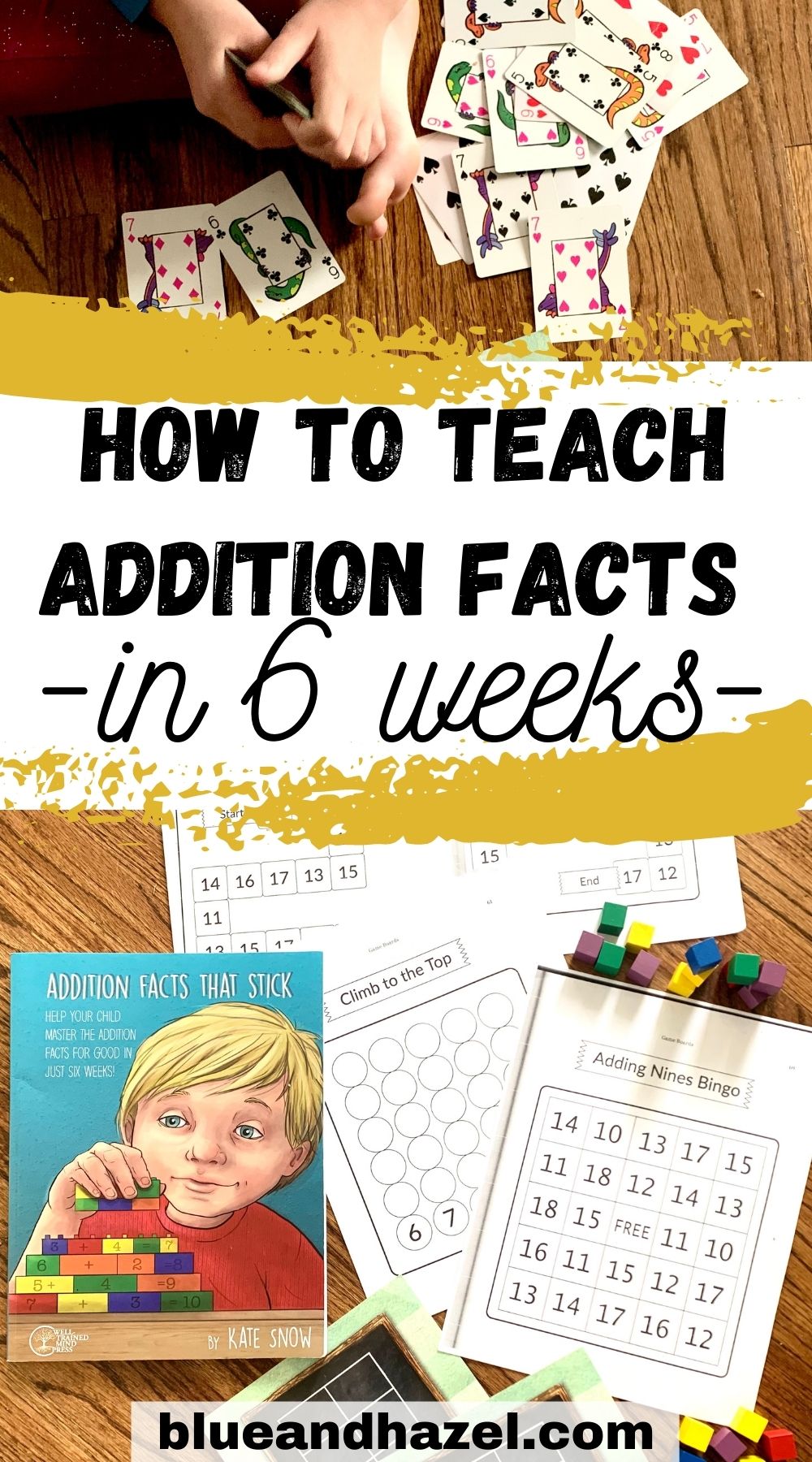
The 6 week program that taught my kids their math facts without flashcards
Addition Facts That Stick is written by Kate Snow, a former 5th grade math teacher turned homeschooler and math tutor. She has also written math curriculum herself, and is a contributor for The Well Trained Mind.
Homeschool parents highly recommended this math supplement in a few of the homeschool Facebook groups I am in. Plus, it only takes about 15 minutes a day for 6 weeks.
For us, it was the perfect switch up when our homeschool routine was getting stale. I put our other math on hold for 6 weeks, and it was the best decision for us!
Some days we only did this for math, while other days I’d do Addition Facts That Stick in the morning and 10-15 minutes of math from our main homeschool curriculum in the afternoon with my 1st grader.
It just depended on the day. I wasn’t concerned about “getting behind” with our other math, because for 6 weeks, getting the addition facts down was my priority. And the kids loved their “new math”.
Addition Facts That Stick Review on YouTube
If you prefer video, I’ve made a review on YouTube. Or, scroll down to read more!
When should kids start to know their addition math facts?
Usually, it’s somewhere around 1st or 2nd grade.
Kindergarten math doesn’t really focus on knowing math facts, but introduces math concepts and patterns. Kindergarten does cover adding up to 10 though, usually through visuals and hands on learning.
By the end of first grade kids have usually covered numbers that add up to 20, so 1+1 to 9+9.
That’s 81 total math facts, which is a lot!
What we used for our 1st grade math curriculum
We had been using Math Lessons For A Living Education and playing math games for my son’s 1st grade year. There were so many parts of it I loved, as well as parts I didn’t.
But my son hadn’t grasped addition facts at all past 10.
Even when we played games, he would guess or count 8+4 on his fingers. It made me doubt my curriculum or my ability to teach him.
I wondered how he would memorize them. Our curriculum used right brain flashcards with the answer on them. (I’d never seen that method before).
You can read my full level 1 and 2 math review here.
If Math Lessons For A Living Education is working for you family, then keep using it! It really does a great job in SO many ways.
And you can easily use Kate Snow’s Addition Facts That Stick right alongside it.
Why just memorizing math facts isn’t the best approach
Without tools to improve number sense or mental pictures to figure out the answer, math facts will likely come in and out of short term memory.
Addition Facts That Stick helps kids develop mental pictures and strategies to figure out the answer until they can quickly recall it without the visual! Then, kids practice practice practice through games and worksheets.
It trains kids to see numbers on 10 frames in terms of making groups of 10’s or 5’s, and finding the leftovers.
This is not at all a tool I used growing up (so I was learning too because I still count up on my fingers even as an adult)!
Having to count on his fingers for everything was slowing my son down and tiring his brain! Especially when we were learning new concepts like how to carry numbers from the ones to tens place with Masterbooks level 2.
That’s why I love it Kate Snow’s 6 week addition fact tune up. It’s cheap, and I didn’t have to commit to a full year curriculum, or even switch my curriculum!
Just 6 weeks of practicing addition facts using a new method. Now I could do that, and so can you!
How to memorize math facts quickly using Addition Facts That Stick
Kate uses a 3 step process for learning math facts. It’s unique because it’s not JUST games, or JUST worksheets, or JUST visuals.
It’s a combo of them used with groups of similar type addition facts, like the +1 & +2 facts on week 1. And the harder ones at the end like +9 and +8 facts.
As skeptical as I was, it works and has helped both me and my kids improve quickly!
Each week will follow this same pattern, covering new addition facts.
Step 1: Teach your child the strategy using visuals.
Below is a photo of week 1, day 1. Every week always starts with the 10 frame and counters.
Kate helps kids to look for how many blocks are there, how many are NOT there, and how to think in terms of groups of 5 and 10. It’s slow at first, but then it clicks!
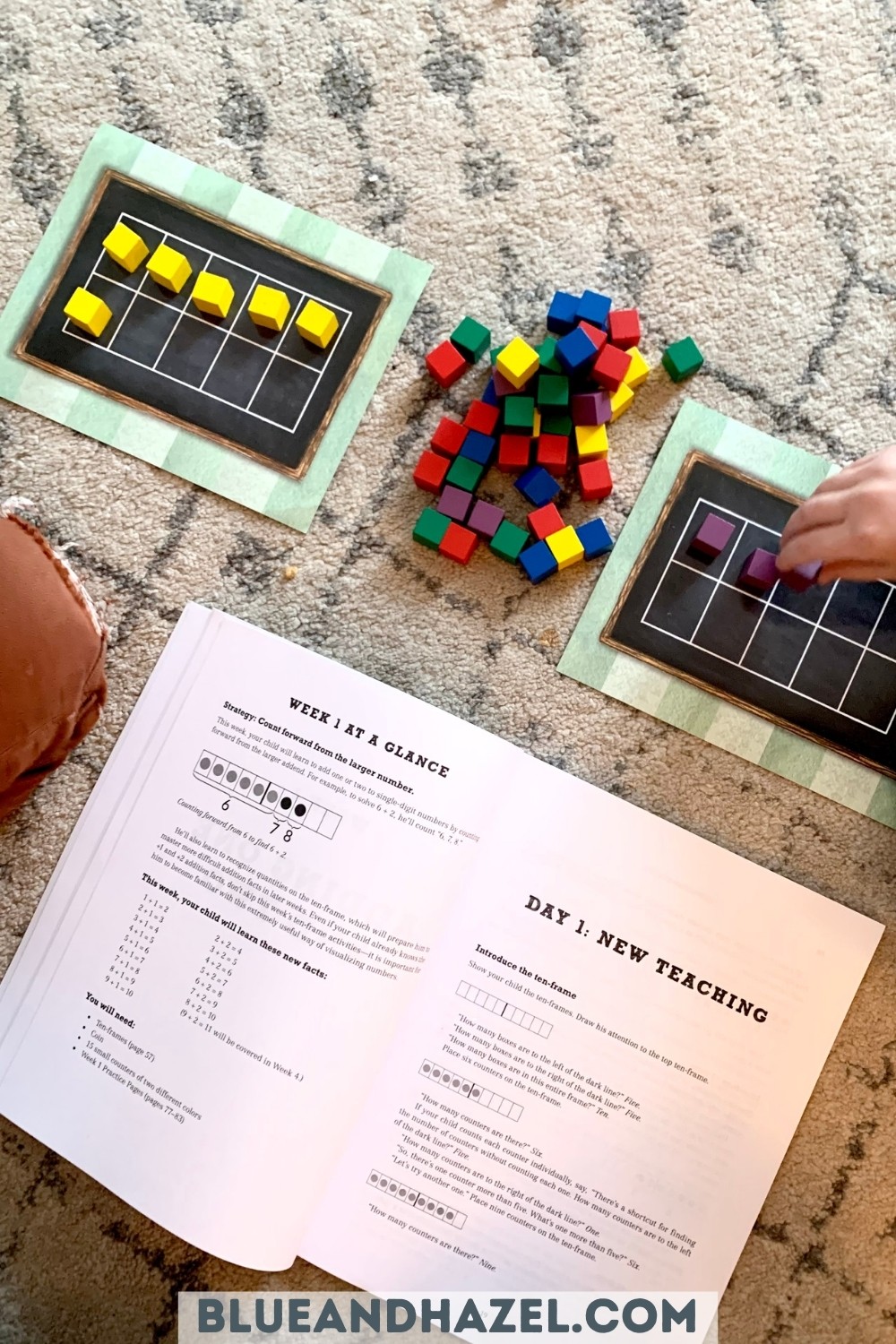
In this case, we used 10 frames and colored blocks I had already. (10 frames are also included in the back of the book).
Day 1 of each week always starts with an easy to teach lesson PLUS a math game. You will use the 10 frames every week!
My kids were learning to SEE the connection first, many times over. Sometimes we would use the blocks and 10 frames just for a couple of days, and other times all week if they weren’t getting it.
I noticed by the last 1-2 days of each week, they barely looked at the 10 frames because they knew the answer already.
Step 2: Practice with games

Each week, Kate includes a new game to play each day plus a worksheet.
My kids LOVED all the games, and it’s recommended to play more than once a day.
All you need for games is a deck of cards, and a coin! She includes the game boards in the back of the book. You can tear them out of make copies.
Step 3: Mix old familiar math facts with new math facts using a worksheet
Each daily worksheet comes with 24 practice problems. There’s always a mix of about half review from previous weeks and half new ones.
This is independent work. I graded it after and had them correct any wrong answers.
If my kids couldn’t do the worksheet alone we would pause and do more practice with the 10 frame.
That was our +8 week around week 5…it was really hard for them and they were guessing a lot.
Here’s an example of a practice page assigned for week 4 which was “Adding Nine”.
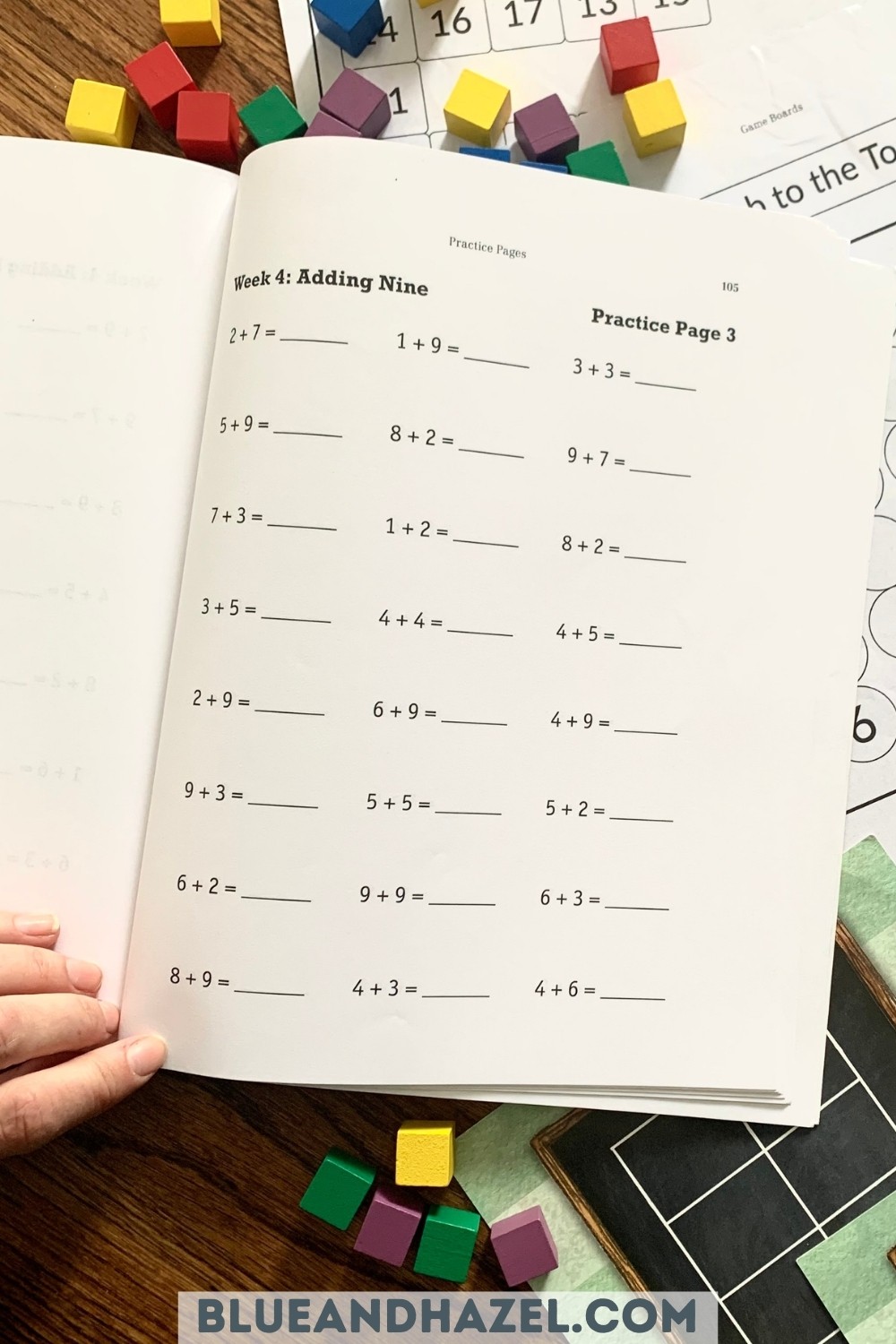
Here’s what a week looked like using Addition Facts That Stick
Addition Facts That Stick took us 6 weeks and 15 minutes a day.
Day 1 of each week had a quick lesson (I mostly just read her words out loud in the book). Then, the kids played a NEW weekly game.
Each day for the rest of the week we played that week’s game again and did 1 worksheet. If I remembered, we would play the game again later in the afternoon.
Playing the game more often will only help! They are “mathy” versions of popular games like go fish and addition war.
Kate tells you exactly which cards to use each week and how to play.
Side note, when we got to week 6 and were playing “war”…I quickly saw the game could go on forever! Making math less than fun. So we set a 15 minute timer and then stopped to do the worksheet.
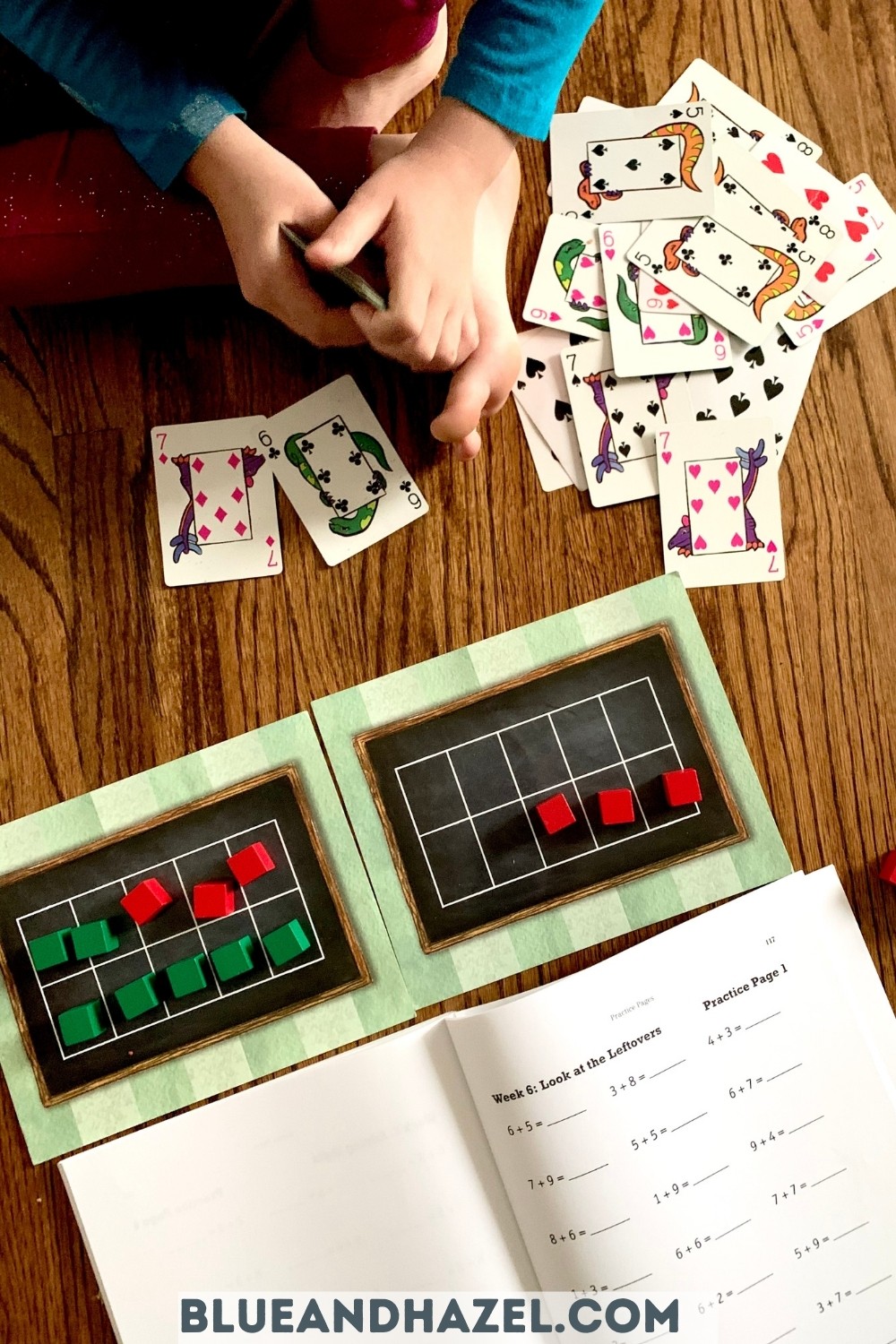
Usage rights for printing Addition Facts That Stick
You are allowed to print copies of pages for use within YOUR family, but not to give away.
Since I’ll definitely be using this again as review and also with my younger kids as they get older, I did make copies instead of tearing out the perforated pages in the book.
I printed out 2 copies of each of the daily worksheets and the printable game so I have the option to reuse this book down the road.
How to know if your child is old enough to use Addition Facts That Stick
Kate Snow, the author recommends that your child:
- recognizes written numbers 1-20
- understands the concept of addition (two numbers added together makes a larger number)
- has been introduced to place value (understands that 10+3 is the same as 13)
- is around 6 years old or older
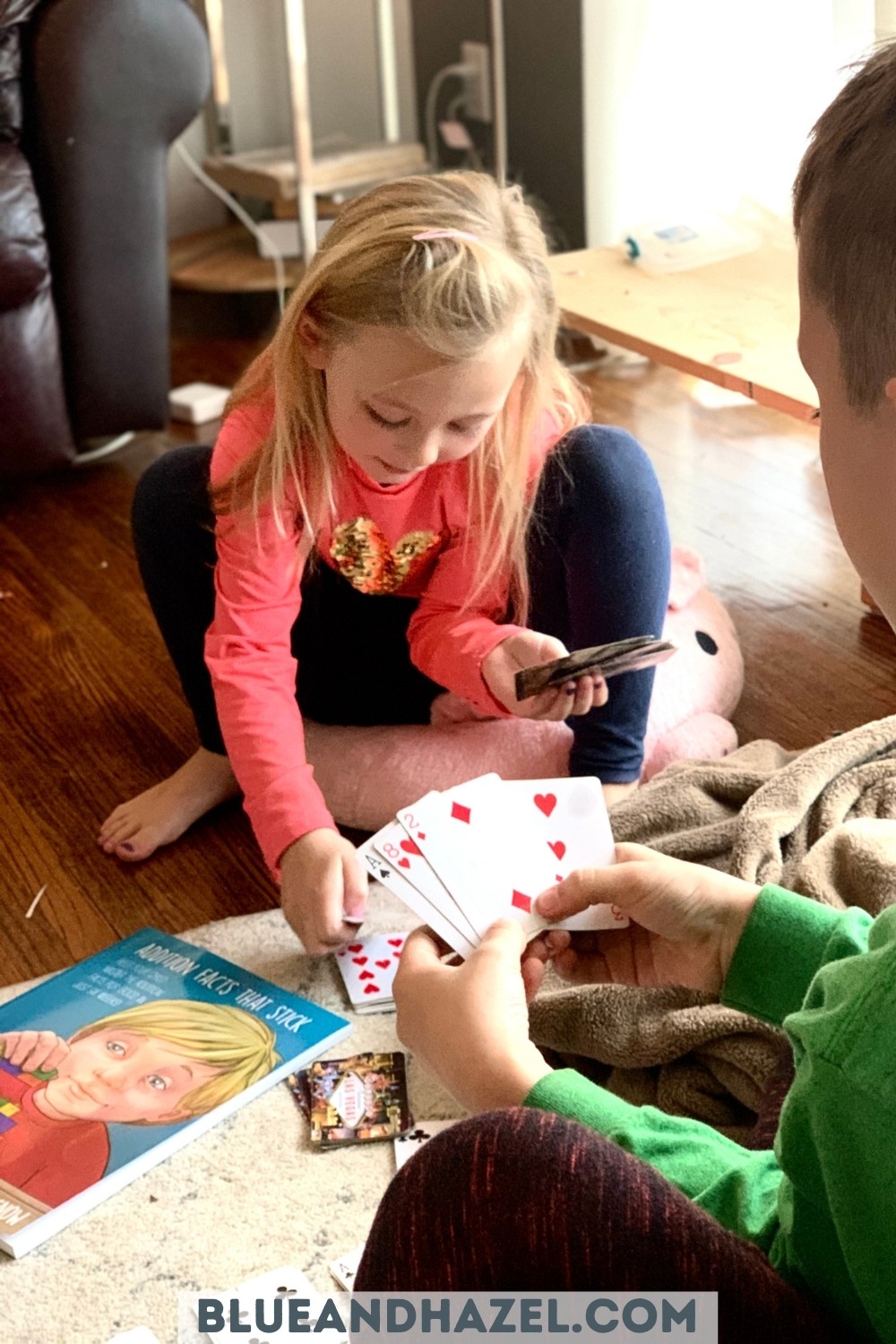
Even though my newly 6 year old daughter was just in kindergarten (nearing the end of her year) I decided she could also try it with my son who was ending 1st grade.
I wasn’t going to force her if it seemed too much. But she is sharp, wanted to do it, and loved the games! While she was ready, my son would not have been at that age.
By the 5th week when we were learning a +8 pattern, she was having a hard time and I didn’t force the worksheet. She needed more practice with the 10 frame and that’s ok.
My 7.5 year old seemed to do better, but +8 facts were harder for him to visualize and memorize as well.
So use your best judgement knowing you can always wait and come back to it later!
Here’s her post on everything you need to know about teaching addition facts.
More early elementary math games I recommend on Amazon
We have been slowly building up our gameschool tools, especially for math! It’s the perfect way to play math, and get practice in without worksheets.
I enjoy it a lot more than regular curriculum! Here’s my big list of math games!
We have used many of these for kindergarten and 1st grade. You can read the recommended ages for each game as well. But most practice addition and subtraction through 10 or 20.
Feel free to ask me any specifics on the games in the comments.
Be realistic that kids will struggle and need more math facts practice
This is my two cents, but I don’t fret if my kids just aren’t getting it.
As with anything this book is a TOOL, and your child is unique. The way they learn may be slower or faster. We all process numbers differently!
The first few weeks were so much easier for my kids than week 5 and 6 with the +8 facts and +7 facts. I didn’t really know what to do.
Pressuring my son to KNOW that 8+7=15 by using the book’s method didn’t go well. Because he felt pressured! So I had to back off a bit, and watch how he tried to figure it out.
If he was clearly guessing, I placed counters on the 10 frames so he could see it. Now I have teacher tools I didn’t have before, even after we move on from using Addition Facts That Stick.
Save this post for later & let’s connect on Instagram!
Thanks so much for reading this review and I hope it will help your kids in whatever math program they are already using! Remember it’s never too late to use this…it even helped me A LOT at age 32!
If you enjoyed this post, would you take a minute to share on Facebook or Pinterest? Thank you!
I’ll see you over on Instagram where I share homeschool life and behind the scenes day to day activities!